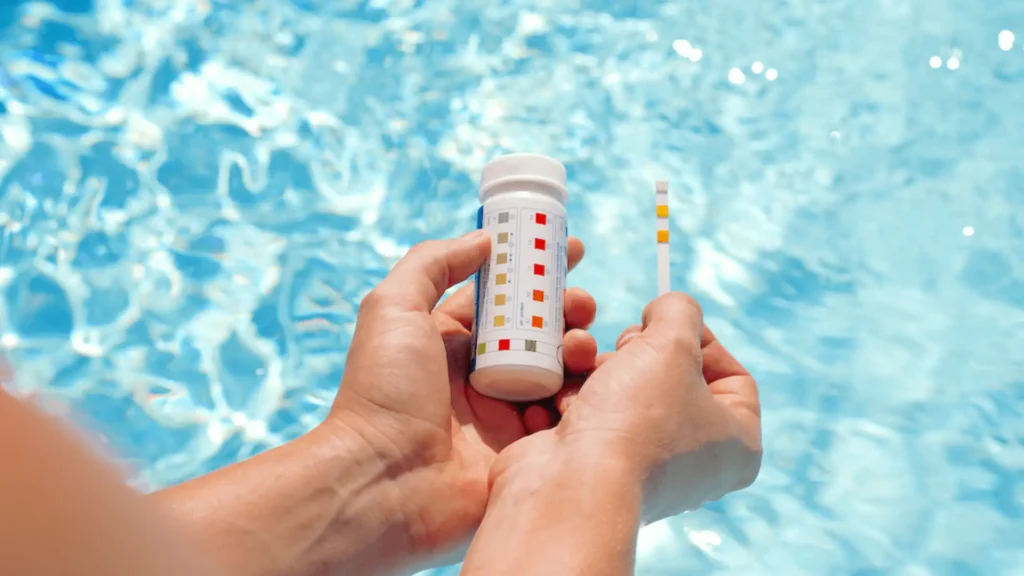Maintaining the right pH and alkalinity levels is crucial for effective pool maintenance. These factors directly impact water quality, swimmer comfort, and the longevity of pool equipment. Here’s a detailed guide to understanding pH and alkalinity and their role in maintaining a balanced and healthy pool.
The Role of pH in Pool Maintenance
The pH level of your pool water measures its acidity or alkalinity on a scale from 0 to 14, with 7 being neutral. Ideally, pool water should have a pH level between 7.2 and 7.8. Maintaining this range is vital for several reasons. First, a balanced pH ensures chlorine remains effective in sanitizing the pool. If the pH is too high or too low, chlorine’s ability to kill bacteria and algae diminishes. Additionally, a balanced pH prevents skin and eye irritation for swimmers and protects pool surfaces and equipment from corrosion or scaling.
Understanding Total Alkalinity
Total alkalinity (TA) refers to the concentration of alkaline substances in the water, primarily bicarbonates, carbonates, and hydroxides. It acts as a buffer, stabilizing the pH level and preventing drastic fluctuations. The ideal range for total alkalinity in pool water is 80 to 120 parts per million (ppm). Proper alkalinity levels help maintain a stable pH, reducing the need for frequent chemical adjustments. Low alkalinity can lead to erratic pH levels, while high alkalinity can cause cloudy water and scaling on pool surfaces.
Balancing pH and Alkalinity
Effective pool maintenance involves regularly testing and adjusting both pH and alkalinity levels. Begin by testing the water with a reliable test kit. If the pH is outside the ideal range, adjust it using pH increaser (sodium carbonate) or pH decreaser (sodium bisulfate). It’s crucial to address alkalinity first, as it impacts pH stability. To raise alkalinity, add sodium bicarbonate, and to lower it, use muriatic acid or a specialized alkalinity reducer. Make adjustments gradually, allowing the water to circulate and retesting to ensure stability.
Impact on Pool Maintenance
Maintaining balanced pH and alkalinity levels simplifies overall pool maintenance. When these levels are stable, chlorine works more effectively, reducing the need for frequent shock treatments and additional chemicals. Balanced water also prevents scale buildup and corrosion, extending the lifespan of your pool equipment and surfaces. Additionally, well-balanced water enhances swimmer comfort by preventing skin and eye irritation, ensuring a pleasant swimming experience.
Tips for Regular Monitoring
Consistent monitoring and maintenance of pH and alkalinity levels are essential for a healthy pool. Test the water at least twice a week, more frequently during heavy usage or after rainstorms. Keep a log of test results and chemical adjustments to track trends and anticipate future needs. Regularly clean and inspect your pool’s filtration system, as a well-maintained filter contributes to water balance. Consider using automated chemical feeders or pool service professionals for precise and hassle-free maintenance.
Understanding and maintaining proper pH and alkalinity levels are critical for effective pool maintenance. These factors ensure water quality, protect pool equipment, and enhance swimmer comfort. Regular testing and adjustments help maintain a balanced pool environment, making your pool a safe and enjoyable place for all.
Learn more:
Advanced Pool Maintenance Techniques: Going Beyond the Basics for Expert Results
The Importance of Regular Pool Filter and Pump Maintenance for Clear, Healthy Water

